Updated November 2, 2023

| Label (Company) |
|
||
| Country |
|
||
| Format |
|
||
| Number of records |
|
||
| Catalogue number |
|
||
| Catalogue number of side 1 |
|
||
| Catalogue number of side 2 |
|
||
| Matrix number of side 1 |
|
||
| Matrix number of side 2 |
|
||
| Mono or Stereo |
|
||
| Rotation speed, rpm |
|
||
| First release date |
|
Click on image to enlarge
Натисніть на картинку, щоб її збільшити
FIRST PRESSING (released September 25, 1970)
ПЕРШИЙ ПРЕС (видання 25 вересня 1970 року)
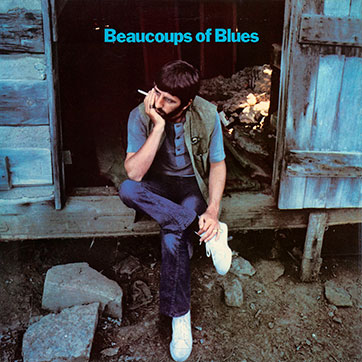 |
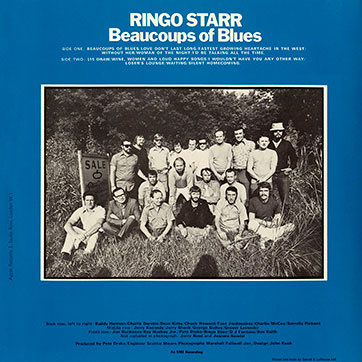 |
|
Var. 1 gatefold, front side Вар. 1 розкладна, лицьова сторона |
Var. 1 gatefold, back side Вар. 1 розкладна, зворотний бік |
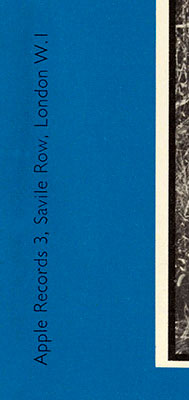
Fragment of the back side (var. 1) with an inscription
Фрагмент зворотного боку (вар. 1) із написом
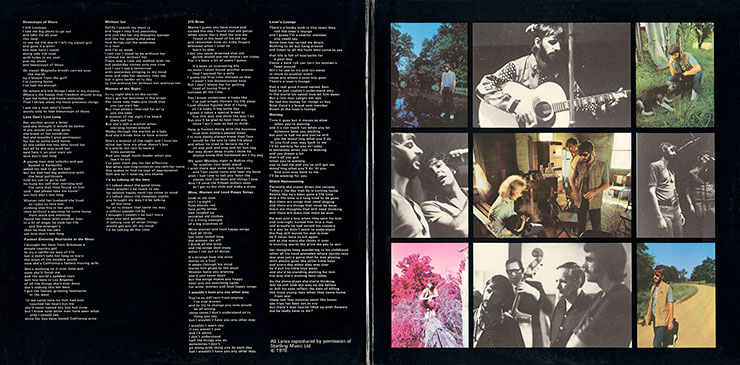
Gatefold cover (var. 1) inside
Розкладна обкладинка (вар. 1) всередині
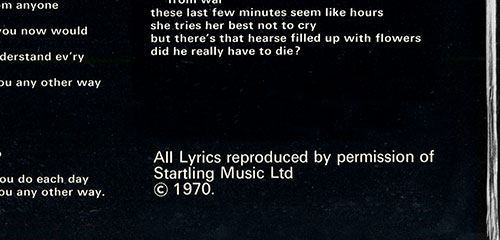
Fragment of the inside (var. 1) with an inscription in big print
Фрагмент всередині (вар. 1) з написом великим шрифтом
![]()
Spine (var. 1) – the front side of the cover up
Корінець (вар. 1) – обкладинка розташована лицьовою стороною до гори
INNER SLEEVE
ВНУТРІШНІЙ ПАКЕТ
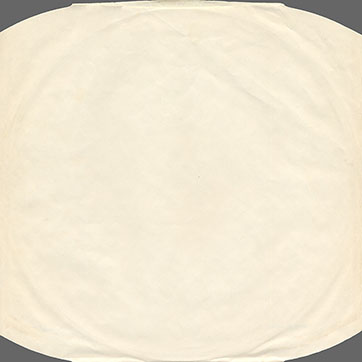 |
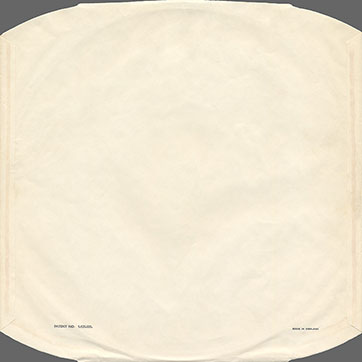 |
|
Factory inner sleeve Фабричний внутрішній пакет |
Back side Зворотний бік |
LABELS
ЕТИКЕТКИ
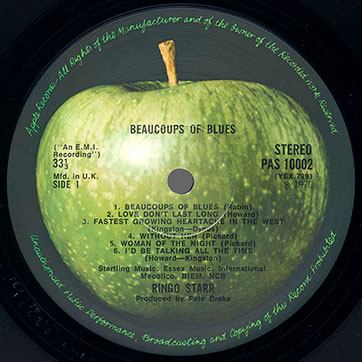 |
 |
|
Var. dark apple, side 1 Вар. dark apple, сторона 1 |
Var. dark apple, side 2 Вар. dark apple, сторона 2 |
REPRESSING (circa 1974-1975)
ПЕРЕВИДАННЯ (приблизно 1974-1975 років)
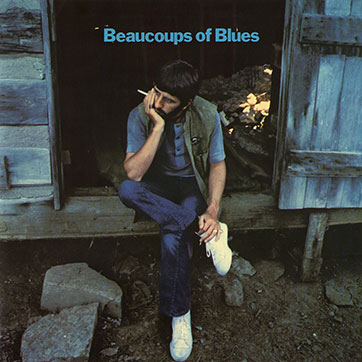 |
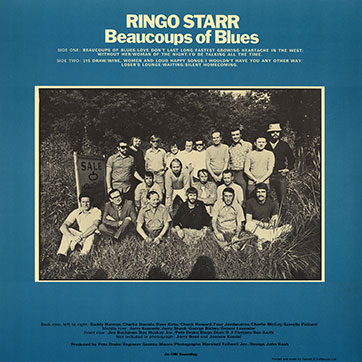 |
|
Gatefold (var. 2), front side Розкладна (вар. 2), лицьова сторона |
Gatefold (var. 2), back side Розкладна (вар. 2), зворотний бік |
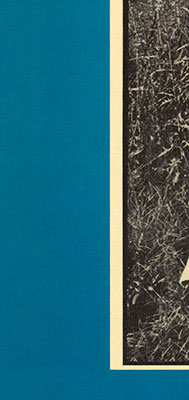
Fragment of the back side (var. 2) without inscription
Фрагмент зворотного боку (вар. 2) без напису
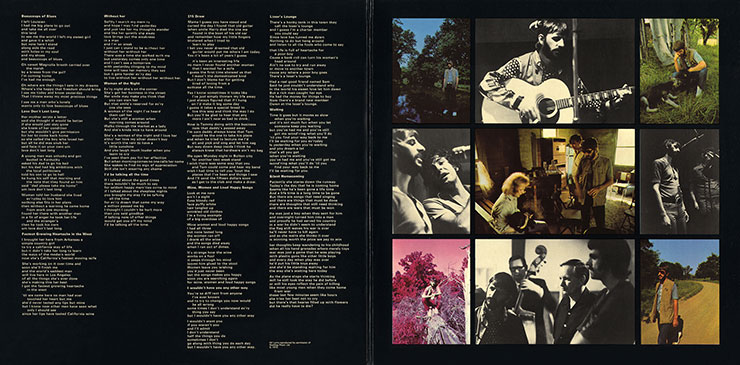
Gatefold cover (var. 2) inside
Розкладна обкладинка (вар. 2) всередині
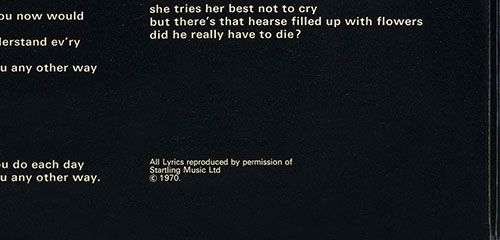
Fragment of the inside (var. 2) with an inscription in small print
Фрагмент всередині (вар. 2) з написом дрібним шрифтом
Spine (var. 2 same as var. 1) – the front side of the cover up
Корінець (вар. 2 такий самий як вар. 1) – обкладинка розташована лицьовою стороною до гори
INNER SLEEVE
ВНУТРІШНІЙ ПАКЕТ
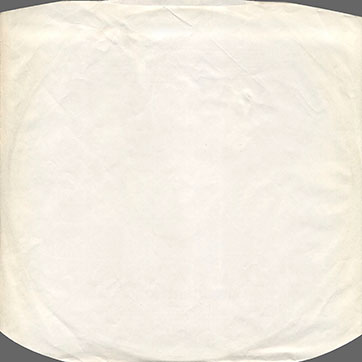 |
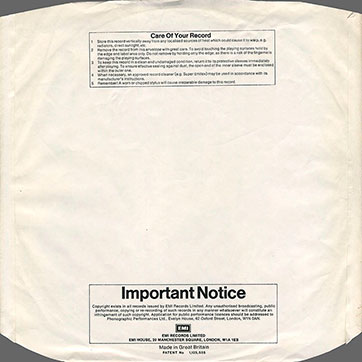 |
|
Factory inner sleeve Фабричний внутрішній пакет |
Back side Зворотний бік |
LABELS
ЭТИКЕТКИ
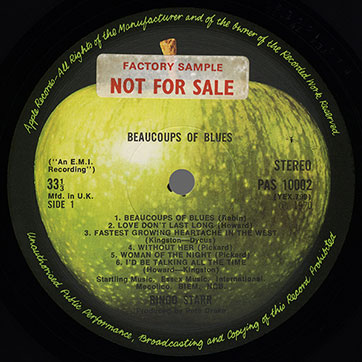 |
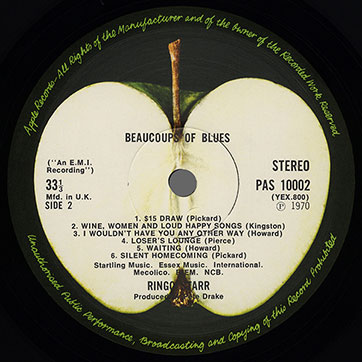 |
|
Var. light apple, side 1 Вар. light apple, сторона 1 |
Var. light apple, side 2 Вар. light apple, сторона 2 |
SIDE 1
N |
Titles and authors |
Time |
Comments |
1 |
Beaucoups Of Blues (Rabin) | 2:33 |
|
2 |
Love Don't Last Long (Howard) | 2:44 |
|
3 |
Fastest Growing Heartache In The West (Kingston - Dycus) | 2:34 |
|
4 |
Without Her (Pickard) | 2:34 |
|
5 |
Woman Of The Night (Pickard) | 2:21 |
|
6 |
I'd Be Talking All The Time (Howard - Kingston) | 2:10 |
SIDE 2
N |
Titles and authors |
Time |
Comments |
1 |
$15 Draw (Pickard) | 3:28 |
|
2 |
Wine, Women And Loud Happy Songs (Kingston) | 2:18 |
|
3 |
I Wouldn't Have You Any Other Way (Howard) | 2:57 |
|
4 |
Loser's Lounge (Pierce) | 2:23 |
|
5 |
Waiting (Howard) | 2:55 |
|
6 |
Silent Homecoming (Pickard) | 3:54 |
Produced by Pete Drake.
Engineer Scottie Moore
Photographs Marshall Fallwell Jnr.
Design John Kosh
Musicians:
Ringo Starr - Lead Vocals, drums and acoustic guitar.
Charlie Daniels - Guitar.
Chuck Howard - Guitar.
Sorrels Pickard - Guitar.
Jerry Reed - Guitar.
Dave Kirby - Guitar.
Jerry Kennedy - Guitar.
Jerry Shook - Guitar.
Buddy Harman - Bass.
Roy Huskey Jr. - Bass.
Charlie McCoy - Harmonica.
George Richey - Fiddle.
Grover Lavender - Fiddle.
Jim Buchanan - Fiddle.
Pete Drake - Pedal steel guitar.
Ben Keith - Steel guitar.
D.J. Fontana - Drums.
Jeannie Kendall - Duet vocal on "I Wouldn't Have You Any Other Way".
The Jordanaires - Backing vocals.
NOTE
Ringo Starr recorded his second solo album in country style. At the suggestion of Peter Drake, a number of composers of this style of music were involved in its creation, who wrote dozens of songs for Ringo. Of the total number, Ringo selected only 14 of them (12 songs ended up on the album and 2 were released as singles). The recording took two days. It took place on June 30 and July 1, 1970 in Nashville at Music City Recorders. The recording sessions were organized by Scotty Moore. On the Internet you can find color photographs of the participants who worked on the album [see Pic. 1]. Only one of the photographs from this photo shoot in black and white appeared on the back cover.
The cover of the first pressing was fully laminated. The catalog number is shown on the spine only. On the back cover on the left side there was a vertical inscription "Apple Records 3, Savile Row, London W.I", and at the bottom there was an indication of the printing house "Printed and made by Garrod & Lofthouse Ltd.".
The record was placed in a standard factory inner bag with rounded edges at the corners. On the back of the white envelope was printed: 'PATENT NO. 1.125.555.' (left) and 'MADE IN ENGLAND' (right).
Circa 1974-1975 the album was re-released with some changes in design. The cover has undergone some changes:
− The vertical inscription with the address of the Apple office on Savile Row in London has disappeared;
− The inscription on the inside spread of the cover 'All Lyrics reproduced by permission of Startling Music Ltd ©1970' is already printed in a smaller font.
The reissue labels are printed on light apple with some text design changes. One of these specimens contained a Type 4 'Factory Sample NOT FOR SALE' sticker. This type of sticker was used between 1971 and 1974. Judging by the fact that the second press has a light label, which appeared approximately in the second half of 1973, it follows that the album was reissued in the period 1973-1974. The date can be further narrowed down by considering that Ringo Starr's first two solo albums were most likely re-released after the huge success of his third album, RINGO, in November 1973, making the re-release in all likelihood 1974-1975.
The reissue record was printed from the same matrices as the original first release. Therefore, the matrix numbers remained the same.
The record of reissue can be in a standard factory inner sleeve with rounded corners (like the first pressings), or in inner sleeves with an additional warning from EMI (Important Notice), which were used later.
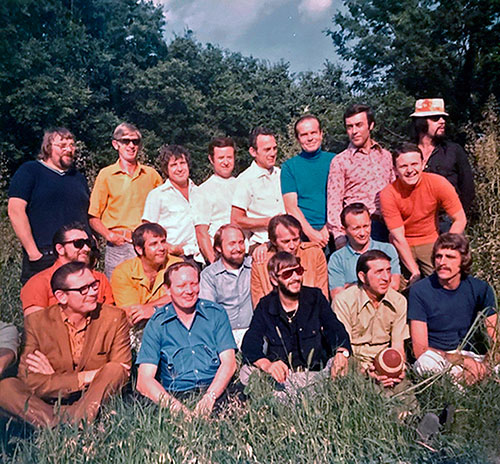 |
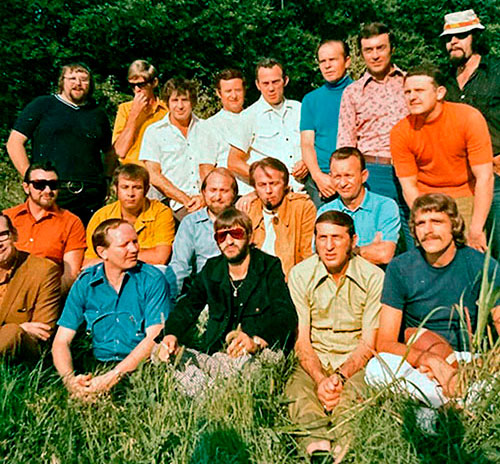 |
Pic. 1. Rejected shots from a photo shoot for the album
Мал. 1. Відбраковані кадри фотосесії для альбому
ПРИМІТКА
Свій другий сольний альбом Рінго Старр записав у стилі кантрі. За пропозицією Пітера Дрейка, для його створення було задіяно низку композиторів цього стилю музики, які написали для Рінго десятки пісень. З усієї кількості Рінго відібрав тільки 14 з них (12 пісень потрапили на альбом і 2 вийшли синґлами). Запис зайняв два дні. Він відбувся 30 червня і 1 липня 1970 року в Нешвіллі в студії Music City Recorders. Організував сеанси запису Скотті Мур. В Інтернеті можна зустріти кольорові фотографії учасників, які працювали над альбомом [див. Мал. 1]. На зворотний бік обкладинки потрапила лише одна з фотографій цієї фотосесії в чорно-білому виконанні.
Обкладинка початкового випуску була повністю ламінована. Каталожний номер вказано на корінці. А на зворотному боці обкладинки зліва знаходився вертикальний напис "Apple Records 3, Savile Row, London W.I", внизу вказівка друкарні "Printed and made by Garrod & Lofthouse Ltd.".
Платівка вкладалася в стандартний фабричний внутрішній пакет із закругленими зрізами по кутах. Зі зворотного боку білого конверта було надруковано: "PATENT NO. 1.125.555." (ліворуч) и "MADE IN ENGLAND" (справа).
Приблизно в 1974-1975 роках наклад альбому повторили з деякою зміною в дизайні. Обкладинка зазнала деяких змін:
− Зник вертикальний напис з адресою офісу компанії Apple на Savile Row у Лондоні;
− Напис на внутрішньому розвороті обкладинки "All Lyrics reproduced by permission of Startling Music Ltd ©1970",було надруковано вже дрібнішим шрифтом.
Етикетки перевидання надруковані на світлому яблуці з деякими змінами в дизайні тексту. На одному з таких примірників виявлено стикер "Factory Sample NOT FOR SALE", тип 4. Цей тип стикерів використовувався в період з 1971 по 1974 роки. Судячи з того, що у другого преса світла етикетка, яка з'явилася приблизно в другій половині 1973 року, отже, перевидання альбому відбулося в період 1973-1974 років. Дату можна ще більше звузити, якщо врахувати, що перші два сольні альбоми Рінго Старра, скоріше за все, були перевидані після величезного успіху його третього альбому RINGO у листопаді 1973 року, то, цілком ймовірно, перевидання припадає на 1974-1975 роки.
Платівку перевидання було відпресовано з тих самих матриць, що й оригінальний перший випуск. Тому, матричні номери залишилися незмінними.
Платівка перевидання може знаходитися як у стандартному фабричному внутрішньому пакеті із заокругленими зрізами по кутах (як у першого преса), так і у внутрішніх пакетах із додатковим попередженням від EMI (Important Notice), що використовувалися пізніше.
Усі вихідні дані щодо альбому (автори композицій, музиканти, подяки тощо) наведено мовою оригіналу в англійській частині примітки.